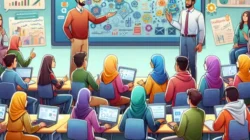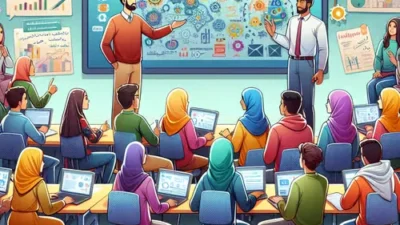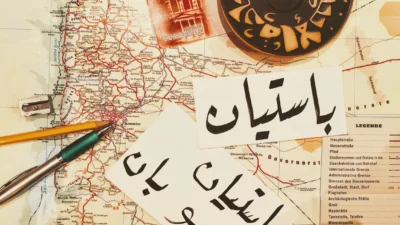The Importance of Learning Arabic in the Context of Education and Culture
In many facets of life, but particularly in the areas of education, religion, and culture, learning Arabic is crucial. Arabic has great spiritual and historical significance for Muslims worldwide, in addition to its linguistic worth as the primary language used to transmit the revelations of the Qur’an and the hadith of the Prophet Muhammad SAW.
It should come as no surprise that Arabic is a required subject in many Islamic schools, ranging from elementary to university. Despite its importance and urgency, learning Arabic is frequently fraught with difficulties, including those related to instructional strategies, student motivation, and the constraints of available media and learning materials.
Many students struggle to grasp grammatical structures (sharaf and nahwu), acquire a large vocabulary, and comprehend how daily Arabic (‘amiyah) and classical Arabic (fushah) differ in language usage contexts.
However, new potential to raise the standard of Arabic language instruction have been made possible by technological advancements and contemporary pedagogical approaches.
Students now grasp Arabic more actively, creatively, and contextually because to innovations in teaching techniques like project-based learning, digital media, and communicative approaches.
Additionally, as more people realise how important it is to learn a foreign language in order to survive in the age of globalisation, interest in Arabic has grown, not just among Muslim students, but also in the professional and academic circles who wish to expand their knowledge of the Islamic world and the Middle East.
Views on Arabic Language Instruction for Elementary School Students in General
Arabic instruction in elementary schools is crucial in laying the groundwork for pupils’ linguistic and religious comprehension. This learning process is not without its difficulties, though, including low student enthusiasm, a dearth of engaging learning resources, and a shortage of teachers with age-appropriate teaching strategies.
Arabic is frequently seen as challenging since elementary school pupils are unfamiliar with its language and grammar. Additionally, students become less engaged in the learning process when an approach is overly theoretical and lacks experience.
To get around this, innovative and enjoyable teaching methods are required, like the usage of educational games, visual aids, and contextual communicative techniques.
A supportive learning environment, developmentally appropriate materials, and the assistance of qualified teachers will all significantly contribute to the creation of a more successful and significant learning environment.
The difficulties of teaching Arabic in primary schools can be solved with the correct approach, and pupils will learn with greater zeal and self-assurance.
The curriculum’s content is frequently overly academic and less relevant, making it difficult for pupils to relate Arabic courses to their own experiences. The short time allotted for learning Arabic frequently results in a hurried and superficial learning process.
Innovative, inventive, and adaptable learning methodologies are required to meet these problems. It has been demonstrated that using technology and audiovisual materials, game-based learning, and communicative learning strategies all boost students’ interest in learning Arabic.
In order to offer content using techniques that are suitable for the peculiarities of the students, teachers must also have the necessary training.
Furthermore, To foster a positive learning environment and encourage the holistic development of Arabic language proficiency, cooperation between educational institutions, instructors, parents, and the community is essential.
Teaching Arabic in elementary schools may be an enjoyable, significant, and enduring learning experience for pupils if the difficulties involved are properly understood and efficient teaching techniques are used.
Students Struggle to Understand the Arabic Language They are Learning
Students often find it hard to learn Arabic, particularly in primary school. The fact that Arabic is not the language they utilise on a daily basis is one of the primary causes. Students are therefore less able to comprehend and retain the information because they are not accustomed to hearing or utilising Arabic outside of the classroom.
Furthermore, another barrier is the Arabic language’s intricate structure. Word forms that vary according to gender, number, and sentence purpose are among the ways that Arabic grammar differs from Indonesian grammar.
This can be perplexing for kids who are unfamiliar with language concepts and makes it hard for them to construct proper sentences like: Changes in gender-specific verb forms, as “ذهب” (he is a man going) and “ذهبت” (he is a woman going), cause confusion for pupils.
Due to the lack of such a framework in Indonesian, pupils frequently make mistakes when constructing sentences and become upset by the numerous rules that need to be committed to memory.
For most pupils, Arabic vocabulary also feels alien. Many words are hard to remember and easy to forget since they don’t resemble their mother tongue. Additionally, kids will forget the vocabulary more rapidly if it is not repeated in different tasks or utilised contextually.
The dilemma is further exacerbated by the less diverse instructional approach. Students soon become disinterested in learning that solely concentrates on memorisation, translation, or writing assignments without a conversational approach. Arabic language content will feel rigid and challenging to comprehend if it is not presented in an engaging way that is suitable for the child’s age.
Another of the impediments is the scarcity of media and educational resources. Learning becomes tedious when visual media like pictures, films, or educational games aren’t used. Actually, for elementary school pupils to grasp language concepts more readily, they require both physical activity and visual stimulation.
A Solution Based Methodology for Helping Students Overcome Obstacles to Learning Arabic
Teachers must use interesting and dynamic teaching strategies to help students, particularly those in elementary schools, grasp the Arabic language. Students’ enthusiasm in learning can be raised by using techniques like role-playing, singing, language puzzles, and vocabulary games.
Students will learn the content more rapidly when they are engaged and happy. Additionally, learning will be more successful if it is connected to real-world situations.
For instance, students are taught basic Arabic phrases like welcomes, introductions, and daily instructions, or they are asked to learn how to name classroom objects. Students find Arabic more relatable and authentic in this approach, which facilitates comprehension.
Read More: The Reasons and Practical Remedies for Indonesian Students Reading Crisis
Implementing attractive educational materials is also highly beneficial. Arabic songs, word cards, animated films, and pictures can help pupils grasp concepts better, especially since elementary school students learn best when exposed to visual and auditory stimuli.
Furthermore, it’s critical to present the information repeatedly and progressively. At every meeting, for instance, introduce five vocabulary words and then utilise them frequently in different activities. Students’ memory and comprehension of the subject matter will be strengthened with regular and repeated practice.
The success of learning is additionally significantly enhanced by the learning environment. By displaying Arabic posters, setting up a vocabulary section in the classroom, or introducing Arabic words into everyday speech, like greeting or stating the day, schools can foster an environment that fosters Arabic.
Teachers must also express gratitude to their students and provide them encouragement. Acknowledgement for their work, modest prizes, or simply a smile and encouragement will boost their self-esteem and drive to study. If kids feel valued, they will be more willing to attempt and not be scared of failing.
Lastly, being the leaders of education, teachers must keep improving themselves. To be able to present content in an engaging and efficient manner, teachers must receive training in Arabic teaching techniques that are suitable for the developmental stage of the students, the use of digital media, and a communicative approach
The Essentials of Building Teacher Competence in Facing the Challenges of Learning Arabic in Elementary Schools
Encouraging pupils to practise Arabic on a daily basis is crucial for teachers. Regular practice in reading, writing, and listening will help pupils become accustomed to Arabic and progressively advance their proficiency.
Additionally, educators are encouraged to use engaging and interactive learning resources, like music, films, instructional games, and learning apps. These media can improve students’ retention of the subject matter and create a more pleasurable learning environment.
Teachers should start by emphasising the mastery of basic terminology and then progressively introduce the material. Students will find it easier to comprehend more complicated grammar and sentence structures if they can learn basic vocabulary that are frequently used in daily life.
Through group projects, talks, or chats, teachers must provide their students the chance to actively engage in Arabic. This kind of direct exercise can successfully enhance language understanding and communication abilities.
Teachers need to be open and patient while explaining things to pupils who are struggling and encouraging them to ask questions. Giving pupils the opportunity to ask questions will improve their comprehension of the subject matter.
Read More: University Students Mental Health: Balancing Social and Academic Pressures
Teachers are also expected to help students create ringkasan or catatan using the course materials. This kebiasaan can help students understand and improve their understanding outside of the classroom. After all, the teacher must constantly inspire students by giving them encouragement and positive reinforcement.
Teacher enthusiasm and patience are very helpful in helping students develop their sense of self-worth so that they may overcome obstacles when learning Arabic.
Writer: Rayya Salsabila Nibras
Student College of Arabic Education Departemet, Faculty of Islamic Studies, Muhammadiyah Prof. Dr. Hamka University
Active in Uhamka Menyala & HIMA PBA
Supervisor: Dr. Muhammad Iman Sastra Minhajat, Ph.D.
Editor: Ika Ayuni Lestari
Language: Rahmat Al Kafi
Ikuti berita terbaru di Google News













